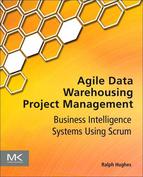Index
Note: Page numbers followed by “b”, “f” and “t” refer to boxes, figures and tables respectively
0-9
2-to-1 design, 59–61
80-20 specifications, 16–17
twelve principles, 15b
A
Agile data warehousing, 325–328
challenge of breadth, 19–22
challenge of depth, 22–26
cycles within, See Cycles
testing requirements, 288–292
warnings, 30–31
Agile modeling, 24
Application wireframes, 136–137
Architectural reserve, 64
Automated and continuous integration testing. see Testing
Automated testing, 294–297
Automation, need for, 292–293
B
Big bang approach, 8
Bullpen, See Commons
developers overtime work, 91–92
diagnosing problems with, 97–102
measuring velocity, 92–93
shallow glide pattern, 99–100
team aggregate progress, 87–92
variations on, 94–96
Business centric, 15–16
Business modeling, 233
Business partner, 15–16
Business rules, 23
C
Capabilities Maturity Model (CMM), 311–312
Categorized services model, 235–238
Caves and commons, 42
Commit line, 50–51
Commons, 42
Community demonstration, 67
Compliance, architectural, 63–65
Component testing, 330–331
Conceptual model, 37–39
Controlled chaos, 273
Corporate strategy, 155–157
Cross-method comparison projects, 333–334
Cycles, in ADW
daily, 40
development, 39–40
sprints, See Sprints
Cycles, in waterfall projects
disappointment, 8–12
D
Daily cycle, 39–40
Dashboarding, 19
Data architect, responsibilities, 262–264
Data cubes, 186
Data topology chart, 316f
Data warehousing/business intelligence (DWBI), 3
Data warehousing reference architecture, 185–186
Database administrators (DBA), 267–268
Decision support, 4
Developer stories for data integration, 178–180
agile practitioners and, 181–182
defining work units, 183f
format, 179–180
forming backlogs, 187–190
load revenue fact, 198
load sales channel, 196–197
need for, 176–178
in requirements management, 180
sample user story, 188f
secondary techniques, 195–205
workshop, 182–185
Developers, 44–45
Development cycle, 39–40
Development iteration, 39
Dimensional model, 234
Disappointment cycle, waterfall method, 8–12
Discovery phase, See Release cycle
Domain model, 37–39
Done, definition of, 40–41
DWBI, See Data warehousing/business intelligence
E
Earned-value reporting, 319–325
Elaboration phase, See Release cycle
Epics, See User stories
Estimating bash, 210
Estimation
accuracy, 227–228
agile estimation, 215–219
causes of inaccurate forecasts, 208–215
criteria for better approach, 213–215
ideal time, 223–227
labor-hour, 104–106
remaining labor estimates, 87–88
story points, 223–227
traditional approaches, 209–213
twelve objectives, 214t
value points, 228–229
Evolving target data model, 297–300
Extreme Programming (XP), 34
F
Fact-qualifier matrix, 23
Financial analysis, 156–157
G
Groupware, 112
H
I
Ideal time, See Estimation
Increments, 15
Initial project backlogs, 144–145
interview, 157–163
Integrated quality assurance, 18
Integration testing, 286
INVEST criteria, See User stories
IT Infrastructure Library (ITIL), 312
Iteration backlog, 48
Iteration length, 73–74
Iterations, See Sprints
Iterative and incremental development, 14–19
J
Just-in-time requirements, 122
K
Kanban, 335–336
advantages, 340–341
L
Lead time, 339
Leadership subteam, 266–267
Lightweight modeling, 137
Logical data modeling, 234
Logical models, 23
M
Meta data, 315–316
Meta scrums, 315–316
Milestones, 318–319
Minimally marketable feature, 171
N
Net promoter score (NPS), 329
O
Online transaction processing (OLTP), 143
Organizational change management, 313
P
Perfect line, See Burndown charts
Personas, 135
Physical data modeling, 234
Physical models, 23
Pipelined delivery, 273–285
as buffer-based process, 283–284
iterations –1 and 0, 276–278
resolving task board issues, 280–282
two-step user demos, 278–279
Prime directive, for sprint retrospectives, 68b
Product owners, 43–44
Programming, accelerated, 59–62
Project architect, responsibilities, 256–262
Project backlog, 46, 48, 66–67, 73, 81, 101, 117, 123, 126, 130, 143–174, 175, 182, 183, 184, 207, 228, 229, 230, 232, 254, 318, 325, 332, 334
Project manager
improved role for, 45–46
as scrum master, 46–47
Project plans, 229–232
Project segmentation, 232–234
Q
Quality of estimates, 330
R
Refactoring, 298
Refactoring databases, 299t
categories for, 300t
converting Type 1 to Type 2 dimension, 301t
sample, 299t
verbs and nouns for, 299t
Regression testing, 286
Release backlog, 48
Release cycle
construction phase, 36–37
discovery and elaboration phase, 36–37
inception phase, 36–37
transition phase, 36–37
Release planning, 218
Remaining labor estimates, See Estimation
Remote teammates, managing, 106–112
Requirements
gathering, 118–122
identifying, 124–125
Requirements bash, 118
Requirements traceability matrix (RTM), 119
Retrospectives, See Sprints
Return on investment (ROI), 228–229
Rework, 246–247
Role modeling, 134–135
Roles and responsibilities, 257t–260t
data architect, 262–264
product owner, 43–44
scrum master, 44
systems analyst, 264–265
systems tester, 265–266
S
Scaling agile, 309–325
application complexity, 310–311
compliance requirements, 311–312
geographical distribution, 311
IT governance, 312
organization distribution, 313–314
organizational culture, 312–313
team size, 311
Scaling factors, 310t
Scope creep, 96–97
adaptations, 20
advantages, 5–6
history, 77–78
time boxes, 41–42
Scrum (daily meeting), 57–59
responsibilities, 44
Scrum of scrums, 315–318
Scrum team, 303–309
automatic and continuous integration testing, 307–309
developer stories and current estimates, 306–307
managed development data and test-driven development, 307
pipelined delivery, 306
pull-based collaboration, 309
time box and story points, 305–306
Segmentation techniques
categorized services model, 243–245
star schema, 238–240
tiered integration model, 240–243
Service level agreement (SLA), 339
Single-pass efforts, See Waterfall methods
Source-to-target mappings, 265
Spikes, See Sprints, nonstandard
Sprint, extending, 102–104
Sprint 0, See Sprints, nonstandard
Sprints, 39
development phase, 55–65
retrospectives, 67–72
story conference, 50–52
task planning, 52–55
user demos, 65–67
Sprints, nonstandard, 74–77
architectural, 75
hardening, 76
implementation, 75–76
spikes, 76
sprint 0, 74–77
Star schema, 235
Story conference, See Sprints
Stretch goals, 51–52
Summary goals, 138
Systems analyst, responsibilities, 264–265
Systems tester, responsibilities, 265–266
T
integrate team efforts, 85–86
monitoring, 86–87
quality assurance, 84–85
Task planning, See Sprints
Team roles, See Roles and responsibilities
Themes, See User stories
Tiered integration model, 235
Time-boxed development, 41–42
Time boxes, See Sprints
U
Unit testing, 195
Use cases, 120–121
User demos, See Sprints
User requirements, See User stories
User roles, 135
acceptance criteria, 140–141
advantages of, 123–124
focus on understanding “who, what, and why,", 134–140
INVEST criteria for quality, 126–127
keeping simple, 132–133
prioritization, 172–173
reverse story components, 134
techniques for writing, 130–141
uncertainty, 133–134
V
Velocity, 14, 41–42, 50–51, 56, 65, 70, 71, 72, 73, 92–93, 94, 95, 99, 102–103, 104, 110, 184, 196, 205, 217, 222, 225, 230–231, 254, 284, 304, 306, 318–319, 334
W
War room, See Commons
Warehouse test engines, requirements for, 293–294
Waterfall methods, 35–36
as a mistake, 12–14
single-pass efforts, 211
“Why isn’t somebody coding yet?!” (WISCY), 120
Work-in-progress limits, 309
..................Content has been hidden....................
You can't read the all page of ebook, please click here login for view all page.
